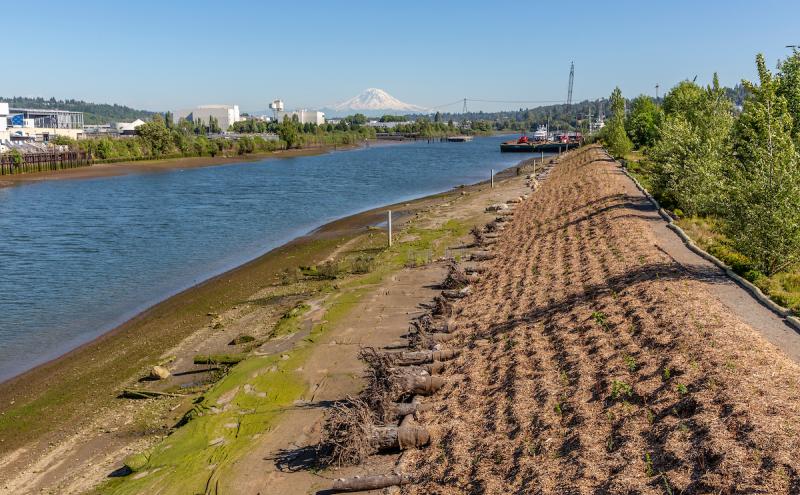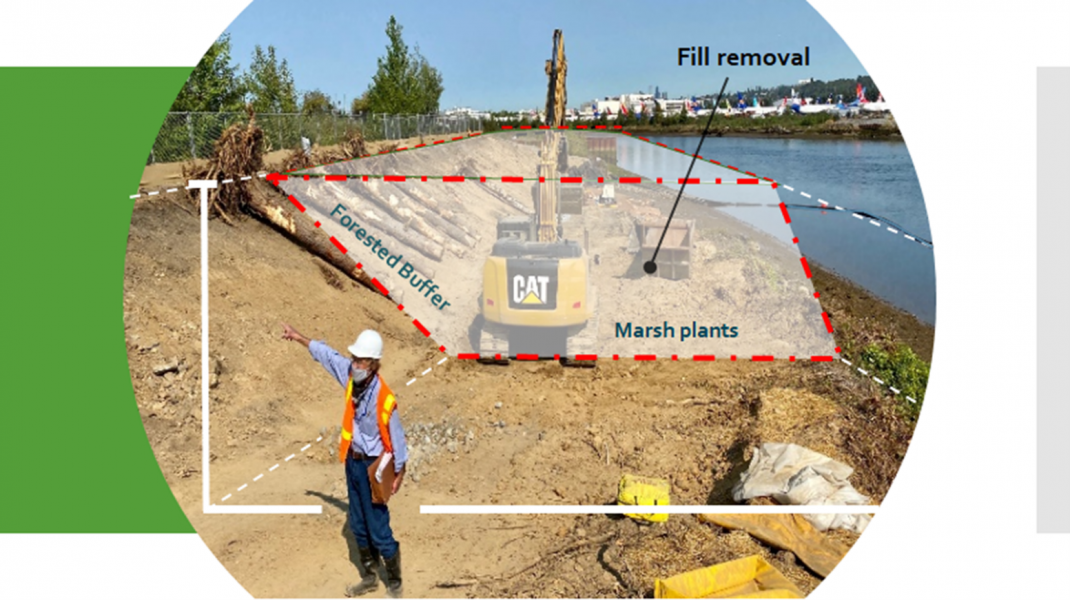
Guided by the Century Agenda
The Port’s Century Agenda outlines strategic objectives to become the greenest and most energy-efficient port in North America. One of the key goals is to restore, create, and enhance 40 additional acres of Green-Duwamish habitat. With the creation of the Duwamish River People’s Park and subsequent restoration sites, the Port is making progress towards this ambitious goal. Port-created mitigation banks generate revenue that enables the Port to advance sustainability initiatives and form new partnerships with environmental leaders.
What is a Mitigation Bank?
Mitigation banks can consist of one large habitat restoration site or a group of smaller sites that generate a ledger of credits that landowners or developers can purchase to offset damage to the environment caused by their projects. Commercial operations can impact wetlands, fish and wildlife habitat, streams, and other valued parts of our ecosystem. Mitigation banks are an important sustainability tool that allow these projects to move forward by creating or restoring habitat to offset environmental impacts.
How Does Mitigation Banking Work?
Mitigation banking is the process of identifying a site that presents an opportunity for preservation, restoration, or habitat creation and working with regulatory agencies, like the U.S. Army Corps of Engineers, the Washington State Department of Ecology, and National Oceanic and Atmospheric Administration (NOAA) Fisheries, to review the bank and determine the amount and type of credits it will generate.
Mitigation banks often have a specific restoration purpose and type of credit that is generated. For example:
- Wetland banks generate credits used to offset damage to aquatic areas, like wetlands or streams .
- Conservation banks offset losses to Endangered Species Act (ESA) listed species, like Chinook salmon, or their habitat.
- Natural resources damage (NRD) banks offer credits that are used to offset injuries to resources such as air, drinking water, and wildlife from actions like oil spills or pollution.
A bank can fall into one of these categories, or it can be approved as a joint wetland and conservation bank, like the Port’s program, with the ability to generate all three types of credits.
Why is the Port Developing a Mitigation Bank in the Green-Duwamish Watershed?
As Seattle’s only river, the Duwamish River is historically and culturally significant. It runs through communities at the heart of the Duwamish Valley, is home to diverse fish and wildlife species, and supports Tribal, recreational, and commercial fisheries This watershed has been heavily developed over time as a center of port and industrial activity in our region, degrading estuarine, riparian, and freshwater wetland environments. The bank will rehabilitate ecological functions and restore priority habitat, while facilitating sustainable growth and development throughout the region. The service area for the mitigation bank includes key sub-watersheds that are critical for local salmon recovery plans – the Lower Green River, the Duwamish Estuary, and marine nearshore areas.
As a major landowner in this area, the Port implements and sustains habitat projects in the Green-Duwamish River. To that end, the Port established a multi-site wetland mitigation and habitat conservation bank that restores critical habitat, enhances ecological function, and supports sustainable growth and development.
Learn more about this project site in the Multi-Site Wetland Mitigation and Habitat Conservation Bank Prospectus.
Duwamish River People’s Park and Shoreline Habitat
The Duwamish River People’s Park and Shoreline Habitat (formerly known as Terminal 117) is the first habitat project built as part of the Port’s mitigation bank. The project restored 14 acres of estuarine habitat along nearly half a mile of Duwamish River shoreline. This includes forested buffer, emergent marsh, mudflat, shallow subtidal, and deep subtidal areas along nearly half a mile of Duwamish River shoreline. The restoration creates valuable off-channel habitat in the marine-freshwater transition zone, enhancing a high-priority migratory corridor for Chinook salmon. In this habitat, out-migrating juveniles can seek refuge while acclimating to saltwater environments before navigating into Puget Sound.
The Duwamish River People’s Park and Shoreline Habitat is the largest restoration project on the Duwamish River, benefiting fish and wildlife for years to come. It also represents a long-term commitment by the Port to steward the Lower Duwamish River. Restoring sites like this one aligns with the Port’s ongoing Duwamish Valley Community Commitment to collaborate with the South Park and Georgetown neighborhoods to promote healthy communities and environments by creating river access, greenspace, and recreational opportunities. The habitat site serves as a learning lab for youth to engage in local environmental stewardship, ultimately building valuable skills for careers in the environmental field.

Riverbank excavation
The bank will generate additional mitigation credits through habitat restoration and overwater cover removal projects at other sites in the lower watershed, including Terminal 25 and other sites. By restoring habitat in saltwater, estuarine and freshwater environments, the Port’s multi-site mitigation bank will improve conditions for salmon across several different phases of their life cycle and create a self-sustaining restoration program that results in continual improvements to wetlands and critical habitat.
Mitigation Credit Release Schedule
NRD credits will be released over a ten-year period based on satisfaction of key project milestones.
| Milestone | Percentage of total credits released |
|---|---|
| Construction complete; "Time-zero" monitoring |
50% |
| Year 1 performance monitoring | 10% |
| Year 3 performance monitoring | 10% |
| Year 5 performance monitoring | 10% |
| Year 7 performance monitoring | 10% |
| Final performance monitoring | 10% |
Terminal 25 South
Terminal 25 South is on the southeast bank of the East Waterway (the segment of the Lower Duwamish Waterway east of Harbor Island), north of South Spokane Street and south of the active Terminal 25 container cargo facility, at 2917 East Marginal Way South in Seattle, Washington.
This project will focus on restoration of valuable fish and wildlife habitat in a marine-freshwater transition zone. The goal of the site is to restore estuarine wetland functions across the site as well as to restore and create riparian habitat and off-channel rearing and refuge habitat for salmonids and other migratory and resident fish and wildlife in the East Waterway. The project would re-establish between 9 and 10 acres of riparian, emergent marsh, mudflat, and subtidal habitat at Terminal 25 South. The project is currently in an early design phase and Port anticipates construction to occur in 2028-2029.
Mitigation Bank Project Sites
- Duwamish River People’s Park and Shoreline Habitat Area (14 acres)
- Terminal 25 (10 acres)
- The Auburn Wetlands (34 acres)
- Pier 48 (4 acres overwater cover removal)
- Terminal 108 (5 acres)
Contact Information
Kathleen Hurley
Senior Environmental Program Manager
[email protected]

